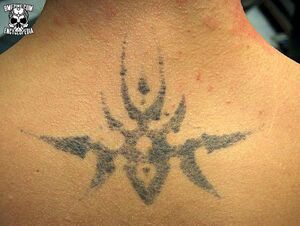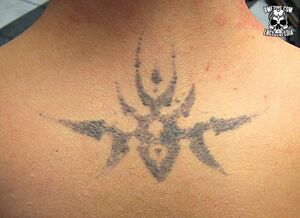Temporary tattoo
Temporary tattoos, unlike henna which can have severe PPD reactions, tend to be nothing more than "stickers", and are not really even worth discussing here. For the purposes of this entry, these are tattoos which the artists claim to be "temporary" with a lifetime usually given as about five years. The two main explanations these artists will give for why the tattoo is "temporary" are:
- Depth Related — Some practitioners will claim that by placing the ink in a "semi-permanent" but not "permanent" layer of skin that the body will reject the tattoo over a period of years. This is not possible because there's not a layer of skin which could be classified as "semi-permanent". The upper layers of skin are constantly renewed over a period far, far smaller than five years, while the deeper layers are effectively permanent.
- Ink Related — Other practitioners and equipment suppliers have produced inks that, in theory, should break down in the body over time, for example by using vegetable-based dyes that the immune system can metabolize or otherwise eliminate (for example, a tattoo with food coloring). This is improbable and should be considered false advertising for a few reasons. The first is that not every person's immune system and healing process is the same. An ink or pigment that may work in one person will not necessarily work in all people, or even a majority of people. Second, by definition, these products would also produce an increased chance of allergic reaction. In fact, they are entirely dependent on the immune system of the person tattooed. This is a factor that cannot be accounted for in a mass-market product. At least, not to a degree that it would be viable as a safe and consistent shorter-term alternative to a permanent tattoo.
Neither of these two methods will likely become widespread due to their inconsistent results and the dishonest business practices of their providers. Neither of these methods will produce a tattoo that magically, evenly fades away at the five-year mark. As seen in the pictures above(both past the five year mark), the fading is fairly minor and very blotchy. Another issue not addressed by the companies advertising temporary tattoos is the scarring caused by the tattoo process itself. This scarring is generally not visible due to the pigment being far more noticeable, but it would likely be visible after the ink "disappears" after five years.
A person considering one of these "five-year tattoos" would be wise to take a bit more time and consider whether they're actually ready to get a tattoo in any form.

